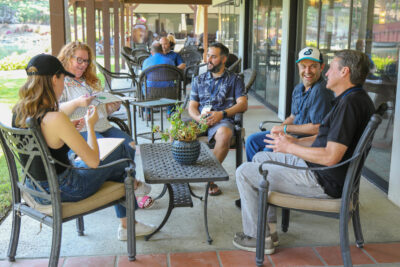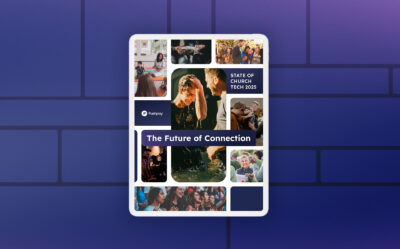
How to Cultivate the Virtue of Stewardship in Your Parish
New evidence suggests Catholics aren't investing in their faith. Here are the four stewardship-cultivating steps your parish needs to take.
The US Bishops, in their pastoral letter on the New Evangelization, Disciples Called to Witness, encouraged Catholics to remember that “a Christian life lived with charity and faith is the most effective form of evangelization.” Charity, the root of the virtues, is the heart that must enliven our evangelization efforts—it moves us to bring our faith to others. When this faith is truly ours, we nurture it, not just by praying in solitude, but by uniting with others to worship in and steward our parishes.
Yet in the case of many Catholics, the evidence suggests they aren’t investing in their faith. They are failing to support their spiritual participation in the Church with a material investment.
When you look at the numbers, it is clear this isn’t a failure of understanding. According to a past Pew Research Center survey, 62 percent of Catholics believe helping the poor and needy is essential to what it means to be Catholic, and 41 percent considered it a sin to buy luxury goods without contributing to the poor.
Catholics know they are responsible for supporting others. They understand stewardship means blessing the poor and needy, and they likely understand that the terms “poor” and “needy” apply spiritually as well as materially. Nevertheless, when a CSPRI 2010 survey reported only 18 percent of Catholics donated money to a religious cause that year, it’s clear that belief is not translating into practice.
In order to mend this disconnect between belief and action, parishes must make the effort to lead by example and to solidify the practice of consistent stewardship. They must become stewardship parishes.
When we talk about “stewardship parishes,” we don’t simply mean parishes that have a Financial Council. Stewardship isn’t about building a new event center. Rather, stewardship is a way of life that uniquely and profoundly draws individuals into community. In a stewardship parish, as the Diocese of Wichita explains, “there is a clear sense of mission, a pastoral plan with specific goals to achieve it, and an organized structure that supports it…Planning promotes unity, involvement, and a sense of belonging…It builds interdependence among the parishioners.”
There are many ways for parishes to achieve this unity of mission, planning, and structured support so all parishioners become true stewards of our parishes. There are also practical steps you can tailor to the needs of your parish as you encourage their spiritual growth and participation in the Church’s work of evangelization.
If the Holy Spirit is leading your parish to begin the work of intentionally cultivating the practice of stewardship in the hearts and faith lives of your parishioners, here are some tips that will help you out:
1. Bring new parishioners into the community
No one likes to be the new person, and this is why it is so important for stewardship parishes to cultivate hospitality. As Dr. Chuck Zech recommends in his book, Best Practices in Parish Stewardship, parishes that emphasize welcoming activities have a high degree of success in their stewardship of time, treasure, and talent. If people are going to feel ownership of the parish (which is the same as feeling as if their contribution matters), they first need to be invited to feel like members of the parish and understand that it is theirs.
Practicing hospitality at your parish doesn’t need to be complicated. In Divine Renovation, Fr. James Mallon advises each parish to have a welcome team large enough to both greet and offer assistance to Mass attendees—but also to encourage “pew hospitality.” Pew hospitality describes small expressions of welcome that range from a verbal greeting to an I’m-glad-you’re-here smile.
Other hospitality practices can be high tech, such as encouraging newcomers during the announcement period to download your parish app and fill out a quick, digital visitor card.
To step up your hospitality game, you could use the visitor information in your app to organize welcome wagons—which could mean anything from bringing a plate of cookies by the house of newcomers to calling visitors up with a personal invitation to an upcoming parish event.
Remember, stewardship begins with an invitation to join with your Eucharistic community. The Mass is the heart of our community; part of our missionary calling within the Church is to make sure all newcomers know they are welcome because our community is also theirs.
2. Creating a community of witness
The International Catholic Stewardship Council, a great resource if your parish hasn’t already begun to make use of them, explains that lay witnesses are an important facet of encouraging flourishing stewardship in any parish:
“One of the most effective means of presenting the stewardship message is through the Stewardship Lay Witness Talk. Properly done, parishioner testimonials send a strong message to members of the congregation, inviting and inspiring others to embrace the stewardship message.”
Lay witnesses aren’t leaders. In fact, it’s better if they aren’t. They are members of the parish who have begun to understand their role as stewards, who can present normal, ordinary models of what it looks like to be stewards by turning their time, treasure, and talent over to God’s service. These witnesses can present their testimonies in front of the parish during the announcements at Mass, or at a parish mission event, or even during the CCD and RCIA classes. One effective way of promoting lay witnesses is to use the blog section of your church app to bring these testimonies to the phones of your parish and to raise awareness of how gifts of time, treasure, and talent are being used in the parish.
For many Catholics, stewardship is a scary topic—one that will condemn them to a life of either utter poverty or endless financial lists and fundraising goals. Neither of these is an accurate picture of stewardship, and this is a hurdle lay witnesses can help overcome. This is why lay witnesses should begin their talks (or short essays) defining stewardship accurately. A good definition:
Stewardship is a response we make in gratitude to God for what has been given to us. It is an intentional, planned, proportionate giving of our time, talent, and treasure.
After defining stewardship, the rest is simple. Lay witnesses should explain their call to stewardship: How did they begin practicing it? What got them involved? What challenges did they face? What benefits did they find in their stewardship journey? These testimonies should emphasize particular needs of time, treasure, and talent, and remind parishioners they can always check the parish app to learn more or even make a donation.
3. Use technology to help support the three “Ts”
A parish app can make it easy for parishioners to inquire about opportunities to give of their time, particularly if you direct them to the calendar function. It can also make it easier for them to learn of needs for talent—whether using push notifications to alert parishioners of specific needs or creating announcements on the app home page to inform parishioners of specific talent needs.
Most of all, an app can help facilitate mobile giving within your parish, which is the way your parishioners want to give in the 21st century.
In the days when cash and checks were the norms of economic life, collection baskets made sense. However, in an increasingly cashless society, this also means that parishioners are unlikely to carry much cash on them, much less a checkbook. When so much of personal finance is done digitally and planned out for the month, an over-reliance on cash and check collections discourages parishioners from making giving a priority, instead relegating it to a weekly afterthought. I can’t tell you how many times I have missed a collection because I seldom carry cash.
I’m not alone in that experience. The US Federal Reserve estimates that there were 144 billion non-cash payments in the U.S. in 2015, valuing at about $178 trillion in transactions. Moreover, the Pew Research Center’s 2016 Online Shopping and E-Commerce survey found the following:
- Eight in ten US adults have bought something online (almost a complete reverse of a June 2000 survey, where only two in ten US Americans had made an online purchase)
- 51% of US adults have used a cellphone to make a purchase
- Nearly one-quarter of US adults make no-cash purchases within a given week, and 75% overall make some cash purchases throughout the week
- 39%t of US adults don’t worry about whether they have cash on hand
It’s not just the rapidly approaching “cashless society” that is changing how we give: It’s where we make our purchases. And for a growing number of Americans, financial transactions happen through their phones more than anywhere else.
In his 2013 book The Mobile Mind Shift, Forrester Research asserts that most people today expect they can get just about anything they want immediately using their phones.
Using mobile giving technology not only streamlines the collection process, but it provides parishioners an easy way to give and to see how it is directly contributing to particular needs and financial goals within the church. Parishioners are enabled to steward when they have the information and ability to respond to particular, concrete needs in the parish as those needs arise.
4. Pray
As Saint Paul reminds the Philippians, “Have no anxiety at all, but in everything, by prayer and petition, with thanksgiving, make your requests known to God.” Every parish has needs. Every parishioner has needs. Whether those needs are material (a new adoration chapel, a new parish school, food for a family facing unemployment, shelter for those living on the streets) or spiritual (a new ministry the parish plans to expand, enough vocations to fill the parishes with priests, the pain of habitual sin, the questions we all face at one point or another like if God is really there, why did this happen?) God pulls us to His Church because we realize that we have needs that we, on our own, are not sufficient to fill.
As members of the Body of Christ, we come to Him because we desire that He give us the bread of life, always. As members of the Body of Christ, we are also charged with the responsibility of continuing Christ’s salvific mission and proclaiming the Good News in the world today as His hands, feet, and mouth. And like Christ, all our efforts towards this mission must begin with prayer.
The Church leaders, whether the pastoral staff, members of various teams, or the members of the finance council, must begin by turning to God in prayer, asking Him to send a spirit of true stewardship to your parish. Place your needs intentionally and explicitly before God—He is a good Father and will give us what we need for salvation.
But don’t limit such intentional prayer to the parish leadership. Yes, we come together as a community to offer God the prayer of the People of God during the Mass, but how often do we pray together outside of that?
Fr. James Mallon instituted a practice in his parish that encourages this kind of prayer. At the start of every Mass, he “invites parishioners…to find a prayer partner, someone they will pray for, and who will pray for them. We are clear that you do not have to know what you are praying for; God knows.” We are, in fact, our brothers’ and sisters’ keepers, and part of stewardship is praying for the various needs we each have, even when the details remain hidden from us.
A parish app can further facilitate this practice by allowing submissions of prayer requests and enabling an easy connection between prayer partners. Such communication need not be detailed, but simply connecting James and Lily to pray for each other this week and, perhaps, James and John next week.
An app can also help inform parishioners of what the parish as a whole is praying for: Maybe Grace hopes to enter the Dominican Sisters, and the parish is fundraising to help her pay off her student loans; or maybe the parish hopes to keep the food pantry open one more night a week this evening; or perhaps the parish needs a new set of vestments for Father Could-Have-Been-a-Basketball-Star.
By making the needs known and enabling parishioners to easily donate their treasure through the app, sign up their time on a calendar mailing, or communicate their talents with a Singer via a short message to Father, technology can help us communicate the needs we have. It can also go beyond that: Technology can enable parishioners to become stewards of these needs through prayer and by having the chance to respond as Christ’s hands, feet, and even checkbook.
As Bishop Emeritus Eugene J. Gerber said, “Stewardship is a truth embedded in our life. We have only to receive it. The deeper we go into stewardship as a way of life the freer we are to hear God’s word, to ponder it, and to put it into practice. Our wants, our desires will be purified and transformed until more and more we want what God wants and delight in it.”
Jesus assumed a human nature to His Divine Person so that He might give us life, and life abundantly. He did so by giving us Himself: His time in ministry, His talents from raising the dead to forgiving sins, and His treasure which is Himself—Body, Blood, Soul, and Divinity. This sacrifice, made present to the whole people of God at each Mass, is our model for stewardship.
At heart, flourishing stewardship is a matter of flourishing discipleship and conformity to Christ: We are each called to give to Christ because He first gave all to us.






